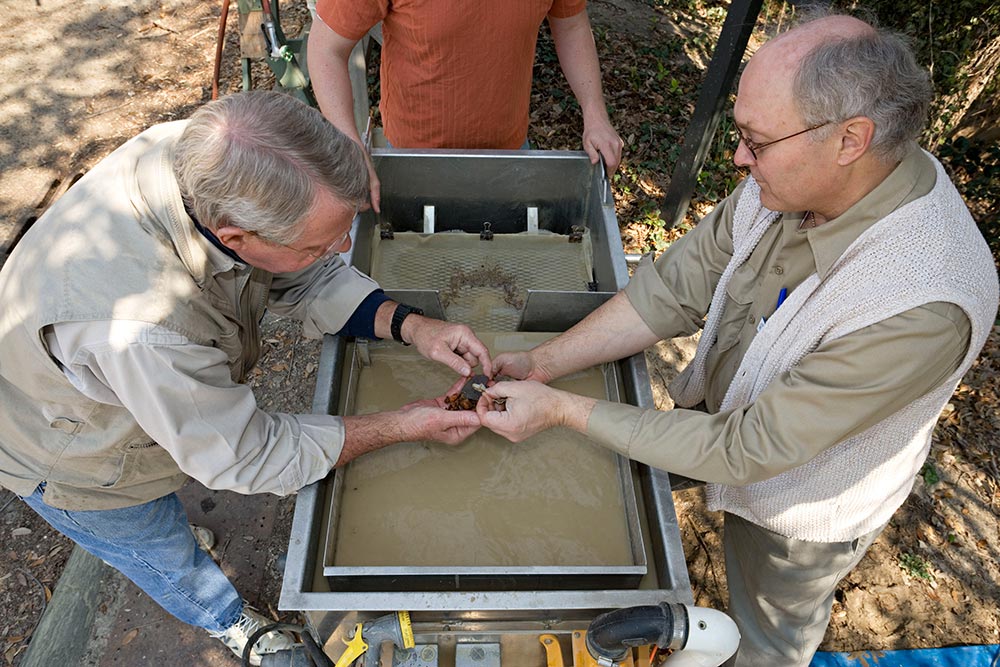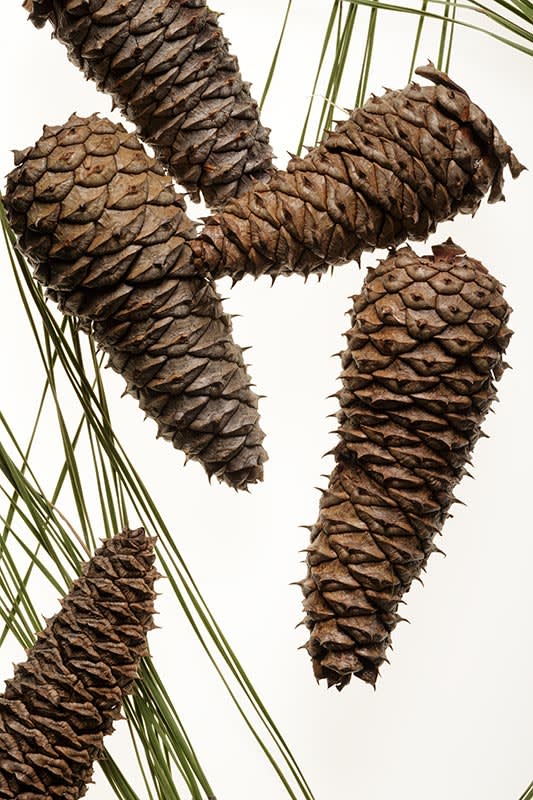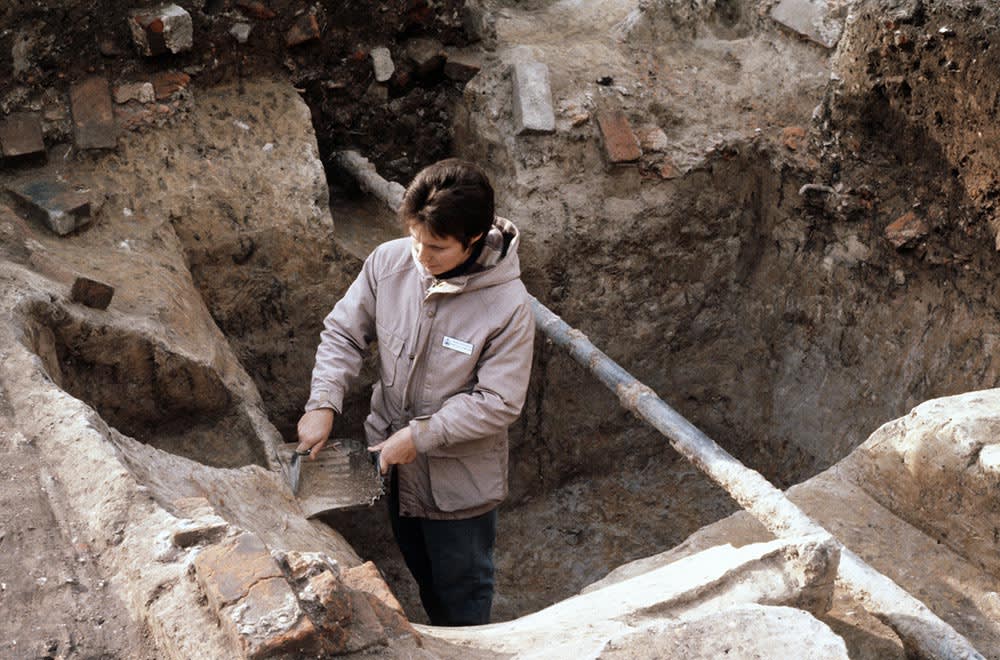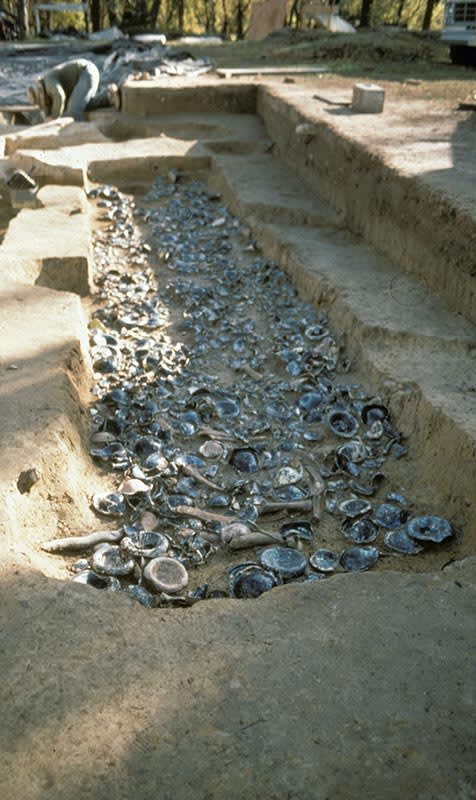To Colonial Williamsburg's original archaeologists, a line of bricks uncovered from the soil told them where a building was, and that was about all they needed to know. They used that knowledge to rebuild many of the Colonial-era buildings we see today.
But present-day archaeologists see something more.
They can imagine a warm day in the early 18th century. A mason is laying those bricks, slathering mortar as he builds row after row of the building's foundation. He may pause for a moment to wipe his brow as a gentle breeze wafts through the construction site. Then he lays the next brick on top of the mortar.

What the brick mason cannot know is that the breeze that relieved him carried pollen from nearby trees. As the pollen settled onto the mortar, it became encapsulated in the building — and became part of the archaeological record.
Send a sample of that mortar to a lab for analysis, and it begins to tell a story about the plant life thriving in the town when the brick was laid. Pollen, it turns out, can tell us quite a lot. The study of it through archaeobotany is fueling scholarship on just what life was like in 18th-century Williamsburg — like how much shade did the colonists enjoy and what kinds of trees did they encounter — before they cut them down.
At the Peyton Randolph House, for example, pollen trapped in the mortar used in the 1715 construction of a bulk head indicates plenty of tree cover — mostly pine, some oak, some maple and hornbeam, said Colonial Williamsburg Foundation archaeologist Meredith Poole. But the pollen encapsulated in a late 18th- or early 19th-century repair reflects a much more open, weedy environment. The tree pollen counts have dropped, and instead, the mortar is full of goosefoot and ragweed pollen.

Few trees survived in Williamsburg at the time of the Revolutionary War, Poole said. Today's Colonial town has far more trees than Thomas Jefferson would have encountered.
"According to firsthand accounts, walking up and down Duke of Gloucester Street was not for the faint of heart," she said. "It was bright. So we know there weren't many trees, but we want to know what kinds of trees there were.
"We are trying to bring new information to our understanding of how this town functioned in the 18th century and how Williamsburg's residents experienced it."
Archaeobotany is expanding the science of archaeology to understand how the town worked as an ecosystem — how the plants had an impact on the people and how the people had an impact on the plants.
Colonial Williamsburg's archaeologists have explored a variety of questions: Can a pit full of blackberry seeds help identify the function of an 18th-century feature? Could a hard-working tradesman have also been a gourmand? What really grew in the gardens throughout the town?
Archaeobotany hasn't always been part of Colonial Williamsburg's archaeological "landscape." The idea that excavation could deliver more than just traces of old buildings was foreign until archaeologist Ivor Noël Hume arrived in the late 1950s.

Seeds, Pits, Pollen and More
Abandoning the use of excavated trenches to locate building foundations, Noël Hume began opening up broad areas to search for a wide range of evidence of human activity. Soil discoloration within his excavation units began to reveal where fence posts and trash pits once stood and where more ephemeral garden features may have been.
One of Noël Hume's first excavations focused on the backyard of Henry Wetherburn's tavern, where he and his crew discovered an 18th-century well. Almost 40 feet down, preserved in the waterlogged sediments, Noël Hume found squash and gourd seeds, and pits from cherries, grapes and peaches. From the muck, he extracted other evidence, as well: cuttings and branches from red oak trees, Virginia pines, red maple trees and mountain laurel. When it came time to assess the archaeological work, he was able to hand this information to the landscape architects to show what was grown in the tavern's yard. It was 1965 and this was the first landscape reconstruction based on archaeobotanical evidence.
Some 50 years later, the field of archaeobotany has expanded far beyond this promising start. With improvements in technology, archaeologists are able to mine ever smaller bits of evidence for details about past environments. Seeds and branches now share the archaeobotanical stage with pollen and phytoliths — the microscopic cells of some plant tissue that persist after the plant decays.
Each bit of evidence has its particular Achilles' heel. Seeds, for example, rarely survive in the ground unless they've been burned or preserved in the damp sediments of privies or wells. Pollen from many species is designed by nature to blow for long distances, so archaeological pollen does not necessarily represent plants that were growing in a particular spot. And while phytoliths are relatively heavy and drop close to where the plant lived, not all plants produce them. And plowing can mix them up in different levels of soil.
"You can't use phytoliths to reconstruct a particular garden," Poole said. "(But they can tell us) how a landscape evolved or, more specifically, how the environment in the front of Richard Charlton's coffeehouse was different from the yard out back. Phytolith analysis tells us that the front was open and grassy, but that the back was full of weeds and unkempt."
Of course, it's no easy thing to pluck pollen or phytoliths from the soil; both forms of evidence are extremely small. Phytoliths may be 1/10 to 1/3 the width of a human hair and while they are a greater nuisance during allergy season, pollen grains aren't much bigger. To isolate them, archaeologists collect soil samples in the field and turn them over to outside specialists for processing and identification.
Large-volume soil samples are collected from promising locations: root cellars, for example, privy pits or around fireplaces. This dirt is then poured into a flotation tank that circulates water from underneath. Any seeds present in the sample rise to the surface and are collected and preserved until they can be identified.
On occasion, flotation can aid in the identification of archaeological features. During a dig behind the Public Armoury a few years ago, archaeologists found a filled rectangular pit about 2 feet long and 18 inches deep. In it were large pieces of window glass and two cow horns, and little else to identify it. So they bagged up some soil and took it to the flotation tank. What floated up were lots and lots of blackberry seeds.
That was a vital clue. Blackberry seeds travel through the human body unchanged. A large quantity of blackberry seeds indicates fill from a privy — one of the few sites used by the 40 Public Armoury workers.
While excavating the home of John Page, which was constructed in 1662, the archaeologists found large deposits of carbonized seeds from early 18th-century wheat that had been stored in the cellar and burned, along with the rest of the house, in a 1730 fire. Though perishable as grain, the wheat became indestructible once it was charred.
"They survived as archaeological data, just as the artifacts did," Poole said.
And then there was the Peyton Randolph planting-bed mystery.

Asparagus?
As far as summers go, 1983 was an especially dry one. Despite the drought, archaeologists digging behind the Peyton Randolph House noticed that in a few isolated areas the soil remained dark and moist, even without watering. Continued digging helped to explain the phenomenon.
Four rectangular holes had been dug into the underlying clay sometime around 1720. Ranging in length from 20 to 32 feet and in width from 4 to 12 feet, these pits had been lined with a crazy array of materials. Two pits contained the bases and necks of wine bottles, oyster shells, animal bones and ceramic fragments. The bones of large mammals — mostly pigs and cows, but also a horse bone or two — lined the third, and the bottom of the fourth pit was strewn with oyster shells. That these could be planting beds was not a far reach. But for what sorts of crops? And how to explain the different types of linings?
The first was a question for an archaeobotanist. Soil samples taken from each of the four beds produced disappointing pollen counts, but more tantalizing seed evidence: blackberries, squash or gourd, sorrel and what appeared to be charred — and badly damaged — seeds from asparagus.
Asparagus is notoriously picky. It requires a well-controlled growing environment, with moist, nitrogen-rich soils. Williamsburg's clay must not have fit the bill because Joseph Prentis, a late 18th-century Williamsburg gardener provided the following advice to would-be asparagus growers:
"Dig a trench as wide as you intend your Beds to be, and two feet deep, lay a layer of Oyster Shells, six Inches, then lay on six Inches of Horse Dung, and as much Mould, continue so to do, till the Bed is done."
Would this explain the lined beds or at least the shell-lined ones? Perhaps John Randolph, whose 1724-1737 ownership corresponds with the dates of the planting beds, was experimenting with the best methods for growing a finicky vegetable.
An archaeobotanist must sometimes recognize a plant by the company it keeps. In this case, the charred and battered asparagus seeds were found in association with those of sorrel, another partial-shade and nitrogen-rich soil-loving plant. Their similar growing requirements add credibility to the identification of Randolph's early 18th-century asparagus beds and highlights the need for multiple strands of evidence to explain a forgotten landscape.

Expensive Tastes
Microscopic evidence can also add dimension to a rather flat view of a colonist. Take John Brush, who lived next door to the Governor's Palace in the early 18th century. A gunsmith, he was one of many artisans in town. A typical workingman. Or so we may have thought of him.
But when archaeologists got into his privy, the dietary pollen and seeds told a different tale.
"He may have died without much money, but he was a conspicuous consumer," Poole said. "The privy produced pollen from plants that would have been difficult to grow — broccoli or cauliflower. We imagine these vegetables on the tables of the elite, but not the gunsmith. There were also seeds from herbs like mint and thyme, suggesting that he was seasoning his food — or even more interesting — that he was using these for medicinal purposes.
"Considering this material alongside the artifacts from John Brush's privy added texture and nuance to our understanding of a specific household. Many of the things that we found were surprising; they were different from what we would expect from an artisan. …
"It really helped us to see John Brush as an individual — making choices — instead of as a social category. We see him in a completely different light," Poole said.
All of this archaeobotany is giving new definition to what is archaeological evidence. Not too long ago, no one would have bothered with seeds and with pollen and phytoliths too small to be seen.
"Now we consider this botanical information on equal footing with artifacts," Poole said. "They are all bits of archaeological information. They are giving us a more colorful picture of life."